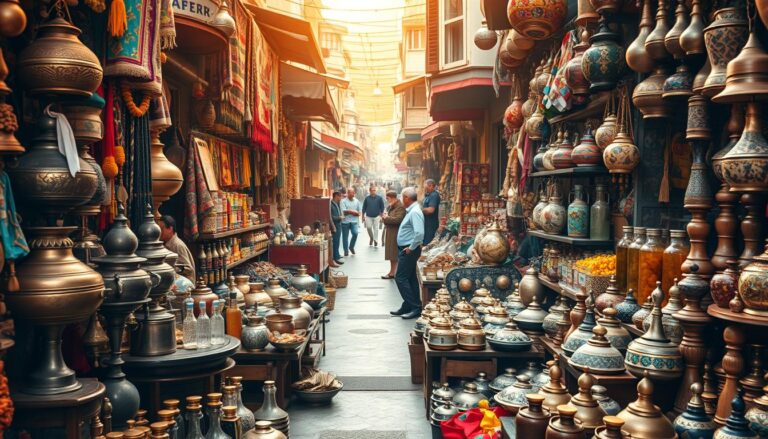Why Mint Tea is the Heart of Moroccan Hospitality
In Morocco, hospitality is a revered tradition. At its heart is the soothing, sweet brew of mint tea. This isn’t just a drink; it’s a symbol of friendship, generosity, and warmth. When you enter a Moroccan home, you’re often greeted with a steaming pot. This signals the start of a warm and welcoming experience.
The importance of mint tea in Moroccan culture goes beyond its refreshing taste. It’s a ceremonial drink that brings people together. It fosters a sense of community and respect. Whether in formal gatherings or casual meetups, making and serving moroccan mint tea is an act of love and respect.
The Cultural Significance of Mint Tea in Morocco
In Morocco, serving mint tea is a big deal. It shows welcome, friendship, and respect. Mint tea, or “Atay,” is a big part of daily life. It shows the country’s rich culture and values of hospitality.
The Symbol of Welcome and Friendship
Serving mint tea is a sign of respect and friendship in Morocco. When guests come, the host makes and serves tea right away. It’s not just a drink; it’s a sign of the host’s kindness and warmth.
The tea is poured into fancy glasses from a high teapot. This makes a frothy top. It shows the host’s skill and respect.
| Cultural Aspect | Significance |
|---|---|
| Serving Mint Tea | Symbol of welcome and friendship |
| Ornate Teapots and Delicate Glasses | Display of hospitality and respect |
| Pouring Tea from a Height | Sign of skill and respect |
The Ritual of Serving Mint Tea
The ritual of serving mint tea is full of tradition. The host picks the tea leaves, fresh mint, and sugar with care. Then, they make the tea in a berrad, a traditional Moroccan teapot.
They serve it with a flourish, making a special experience for guests. This shows how important mint tea is in Moroccan culture. It highlights hospitality, respect, and community.
By joining this tradition, you get to see Morocco’s rich culture. Every cup of mint tea shares a story of warmth, respect, and friendship.
The Rich History of Moroccan Hospitality Through Tea
Mint tea, a key part of Moroccan hospitality, started in the 18th century. Its history in Morocco is filled with cultural exchange and trade. Mint tea is now a big part of daily life, showing the country’s warm welcome.
Origins of Mint Tea in North Africa
Mint tea came to Morocco in the 18th century, brought by traders from China and England. At first, only the rich could drink tea. But as trade grew, tea became more common. Adding mint made the tea refreshing and invigorating.
“Mint tea is the lifeblood of Moroccan social life, a drink that brings people together and fosters a sense of community.”
Evolution Through Centuries
Over time, mint tea has changed, influenced by many cultures and trades. Morocco’s role as a trade hub made its tea culture unique. Today, mint tea is a key part of welcoming guests, showing respect and friendship.
Preparing mint tea is a family tradition, with each family having its own way. This tradition is important to Moroccan identity and shows the country’s warm hospitality.
Essential Ingredients for Authentic Moroccan Mint Tea
Authentic Moroccan mint tea needs specific, high-quality ingredients. The tea leaves and mint must be fresh for a true experience.
Selecting the Right Tea Leaves
Chinese Gunpowder Green Tea is the top pick for Moroccan mint tea. It has a strong flavor and lasts well. Look for tea leaves that are:
- High-quality with little dust
- Have a strong, fresh smell
Chinese Gunpowder Green Tea
This tea has rolled leaves that look like gunpowder pellets. It has a bold taste that pairs well with mint and sugar.
Quality Indicators
When buying, check for freshness and minimal processing. This ensures the best taste.
Fresh Mint Varieties
Fresh mint is key. Peppermint and spearmint are favorites for their refreshing taste. Choose mint that’s bright and fragrant.
Sugar and Other Flavorings
Sugar is added a lot to balance the tea’s bitterness and mint’s freshness. Some might add lemon or rose water, but traditional Moroccan mint tea uses just tea, mint, and sugar.
| Ingredient | Purpose | Tips |
|---|---|---|
| Chinese Gunpowder Green Tea | Provides strong, authentic flavor | Choose high-quality leaves |
| Fresh Mint | Adds refreshing flavor | Use peppermint or spearmint |
| Sugar | Balances bitterness and freshness | Add generously |
Traditional Equipment for Brewing Mint Tea
The traditional equipment for brewing mint tea is key in Moroccan hospitality. It shows the country’s rich cultural heritage. When you brew mint tea like a Moroccan, you join a long tradition. This tradition is a big part of Moroccan social life.
The Berrad: Moroccan Teapot
The berrad is at the center of brewing mint tea. It’s not just a teapot; it’s a symbol of welcome. It’s often made with detailed designs. Choose a berrad that looks good and works well, as it’s the heart of your tea service.
Some of the best mint tea brands have their own berrads. They mix old traditions with new designs.
Decorative Glasses and Trays
Serving mint tea is about how it looks as much as how it tastes. Decorative glasses and trays make the tea service beautiful. These glasses are small and fancy, showing off the tea’s look and color.
The trays, often made of silver or metal, carry the glasses and teapot. They add to the special feel of serving mint tea.
Other Essential Tools
There are more tools needed for mint tea. A tea strainer is key for a smooth tea. Also, a mortar and pestle is used to crush sugar cubes, a common practice in Morocco.
For buying these items, check out mint tea online stores. They specialize in Moroccan tea accessories.
Step-by-Step Guide to Making Mint Tea Moroccan Style
Making mint tea the Moroccan way is a special experience. It combines tradition with simplicity. This refreshing drink is key to Moroccan hospitality. It has a few essential steps to get its unique flavor and aroma.
Preparing Your Ingredients
The first step is to prepare your ingredients. You need the right tea leaves, fresh mint, and sugar.
Measuring Proportions
Measure the right amounts of tea leaves, mint, and sugar. A small handful of fresh mint and a teaspoon of loose green tea are used per serving. Add sugar to taste.
Preparing the Mint
Wash and dry the fresh mint leaves. Gently bruise them to release their oils and flavor.
The Washing Process
The “washing” process rinses the tea leaves with hot water. This removes bitterness and is key for the perfect flavor.
Brewing Techniques
After washing, add fresh mint and sugar to the teapot. Then, add hot water. Let it steep for a few minutes to mix the flavors.
The Three-Pour Method
The traditional way to serve mint tea is the three-pour method. Pour it from a height into small glasses. This cools the tea and adds a frothy top, making it more enjoyable.
By following these steps, you can make a refreshing Moroccan mint tea. It will impress your guests and take you to Morocco’s vibrant souks.
The Art of Pouring: Height and Foam
In Morocco, pouring mint tea is seen as an art form. It shows the host’s skill and kindness. This act is more than just serving tea; it’s a way to show respect and welcome guests.

Creating the Perfect Foam
Making the perfect foam is key in Moroccan mint tea. It’s done by pouring the tea from high into the glasses. This takes practice to get right, aiming for a smooth, velvety foam.
The foam is not just pretty; it shows the tea’s quality and the host’s skill. To get this right, use a traditional Moroccan teapot, known as a berrad. Pour the tea steadily and smoothly.
- Use fresh mint leaves for the best flavor and aroma.
- Adjust the amount of sugar to your taste, but traditionally, Moroccan mint tea is quite sweet.
- Pour the tea from a height to create the perfect foam.
The Significance of Pouring from Height
Pouring tea from high up is a big part of the ritual. It shows the host’s generosity and respect for guests. This act highlights the host’s skill and care, as the foam quality depends on the pouring height.
By mastering this, hosts can make a memorable experience for their guests. It shows the warmth and hospitality that Moroccan culture is famous for.
Enjoying Moroccan mint tea is more than just drinking it. It’s about creating a moment of connection and community. Whether hosting guests or enjoying it alone, the mint tea ritual reminds us to slow down and appreciate life’s simple joys.
Mint Tea Health Benefits and Therapeutic Properties
Adding mint tea to your daily routine can boost your health. It helps with digestion and offers antioxidant benefits. Mint tea is tasty and good for you, improving your overall health.
Digestive Benefits
Mint tea is great for your stomach. The menthol in mint eases nausea and indigestion. It’s a top choice for stomach issues.
Drinking mint tea after meals can help digest food better. It also eases symptoms of irritable bowel syndrome.
Antioxidant Properties
Mint tea has antioxidants from green tea and fresh mint. These antioxidants fight off free radicals. Free radicals can harm cells and lead to aging and diseases.
The anti-inflammatory properties of mint add to the tea’s health benefits.
Mental and Physical Refreshment
Mint tea’s refreshing taste can boost your mood and energy. The scent of mint reduces stress and improves focus. It’s perfect for a mid-day boost.
The caffeine in green tea gives a gentle energy lift. It doesn’t cause the jitters like other caffeinated drinks.
Mint tea is a fantastic addition to a healthy lifestyle. It’s good for digestion, boosts antioxidants, and is a refreshing drink. Choose mint tea for these benefits.
Serving Etiquette and Social Customs
In Morocco, serving mint tea is more than just a drink. It’s a tradition filled with respect and kindness. When you’re invited to have mint tea, you’re diving into a big part of their culture.

The Order of Serving
The way you serve Moroccan mint tea matters a lot. The most honored guest gets served first. This shows respect and kindness, which are key in Moroccan culture.
Proper Way to Accept and Drink
When you get authentic Moroccan mint tea, take it with your right hand. Or use both hands if you want to show more respect. Be ready for more glasses, as serving tea in rounds is common.
Number of Glasses and Their Meaning
The number of glasses served has its own meaning. Tea is usually served three times, for the past, present, and future. It’s considered rude to refuse a glass, so accepting one is a way to thank your host.
| Aspect of Service | Significance |
|---|---|
| Order of Serving | Respect and honor to the guest |
| Accepting Tea | Sign of gratitude and respect |
| Number of Glasses | Symbolism of life’s aspects |
Trying best mint tea in Morocco is more than just tasting it. It’s about getting to know the local culture and customs. By understanding and respecting these traditions, you can really feel the warmth of Moroccan hospitality.
Pairing Moroccan Mint Tea with Traditional Foods
In Morocco, mint tea is a big part of bringing people together. It goes well with many foods, from sweet pastries to savory dishes.
Sweet Pairings: Pastries and Cookies
Mint tea pairs well with ghriba and ka’ak, Moroccan cookies. These treats balance the tea’s coolness with their sweetness. You can also try it with baklava or makroud.
Savory Companions
Mint tea is great with savory dishes too. It’s often served with tagines, slow-cooked stews. The tea’s freshness cuts through the richness of these stews. It’s also good with grilled meats and vegetables.
Special Occasion Pairings
On special days, Moroccans enjoy mint tea with traditional sweets. These include zlabia (deep-fried doughnuts) and msemen (square-shaped pancakes). Mint tea is key to these celebrations, creating a sense of community. It makes any gathering or quiet moment special.
Regional Variations of Moroccan Mint Tea
Traveling through Morocco, you’ll find mint tea is more than a drink. It’s a sign of welcome. The way it’s made and tasted changes a lot from place to place. This shows off local traditions and what’s available.
Northern Mountain Style
In the north, Moroccan mint tea is made stronger. The cold weather and tough terrain make it a warm and lively drink. The tea leaves are top-notch, and it’s steeped longer to get all the flavor.
Southern Desert Variations
The south has its own special authentic Moroccan mint tea. It’s sweeter and smells nicer, thanks to herbs like verbena or rose petals. These changes help beat the desert’s harshness. The tea’s sweetness and scent are a cool break from the dry air.
Coastal Adaptations
By the coast, Moroccan mint tea gets a refreshing twist. It might include citrus or other local flavors. This makes it a lively and refreshing drink. Some of the best mint tea brands come from these areas, where the tea is carefully picked and mixed.
These differences show how rich and varied Moroccan mint tea culture is. No matter where you are, each cup of tea tells a story of local warmth and traditions.
Conclusion: Embracing the Spirit of Moroccan Hospitality
Exploring mint tea in Morocco shows it’s more than a drink. It’s a sign of warmth, respect, and community. Moroccan hospitality is all about serving mint tea, showing a culture that values kindness and friendship.
Embracing Moroccan hospitality lets you see mint tea’s true meaning. It’s about connection and being together. Whether you’re in Morocco or at home, you’re part of a long-standing tradition.
Making and serving mint tea shows Morocco’s rich culture. By doing this, you bring Moroccan hospitality into your life. So, enjoy the simple pleasure of mint tea and let its warmth stay with you.







